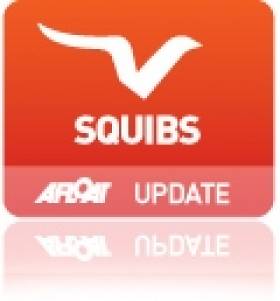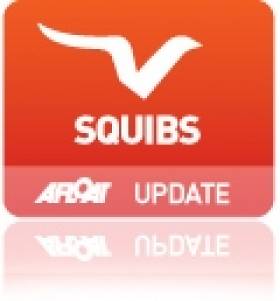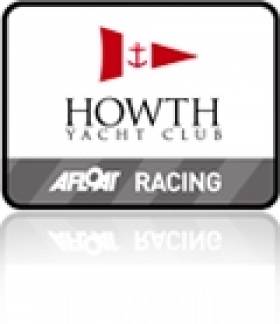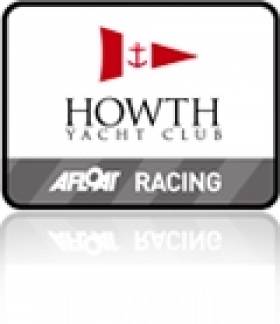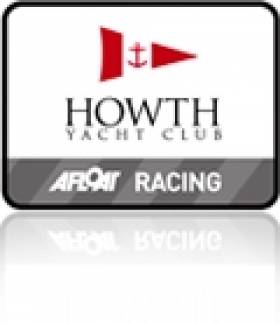Displaying items by tag: squib
Squib Title Wide Open After Light Air Races off Howth
#squib – Yesterday there was no racing at the National Squib Championship in Howth due to a rough sea state and winds of 29knots.
Today we had the opposite conditions, with not enough wind. Race officer David Lovegrove had his hands full with the unsuitable weather conditions that he had to deal with. Did he rise to the occasion? The answer is yes, He and his team made all the right decisions on a very difficult day.
When the fleet got out to the start area there appeared to be three winds fighting for supremacy, one from the north, a sea breeze from the east and the forecast breeze from the south east.
The OOD had no choice but to postpone racing until one of the winds dominated. After about and hour, he laid a course, and made the necessary signals on the committee boat. About three minutes before the start gun he had to abort the start when all of the Squibs lining up to start on starboard tack, suddenly gybed.
Eventually a breeze filled in and a race was started. The Squib fleet were raring to go, so there was a general recall. On the second start under the 'U' flag the fleet started on a windward-leeward course with about 5 knots of wind. On the first beat the Squibs which headed towards Portmarnock beach on the right hand side of the course found a wind bend which took them to the windward mark. It was former NSOA chairman David Wines and Keith Davies from West Hoe Sailing Club in 'White Magic' who lead the fleet from frequent championship competitors Gerard Dyson and Tony Saltonstall from Royal Yorkshire Yacht Club in 'Alchemy'. On the run the wind disappeared completely. The 49 competitors hunted for wind, which eventually came from the shore at about 6 knots. The O.O.D. decided to finish the race off the leeward mark, reducing the race to one lap of the course, at which time the finishing positions were a reversal of the places at the first mark.
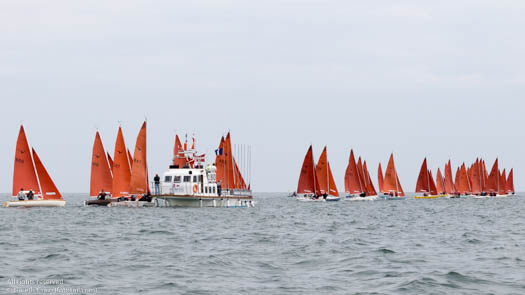
1st. Alchemy, 800, Gerard Dyson and Tony Saltonstall R.Y.Y.C.
2nd. White magic, 828, David Wines and Keith Davies. W.H.S.C.
3rd. Helmut Shoing II, 105, Nigel and Jack Grogan. R.C.Y.C.
This result cracked the regatta results wide open.
Race five followed immediately after the completion of the previous race.
Again the wind teased the O.O.D. endlessly. As soon as a real wind appeared, it disappeared again. Eventually a reasonable light wind covered the whole course. Starting arrangements were made. Again the OOD had to abort the race during the starting sequence due to a ten degree shift which favoured the pin end of the line. When the fleet tried to start again there was a general recall. On the second attempt under the 'U' Flag the fleet got away with a five lap windward leeward course. Who would come to the fore this time? The wind came and went over the duration of the race. On the second lap the wind went very light and a new 10 knot breeze came form out to sea. This race was concluded after three laps. At the finish the placings were:
1st. Banshee, 65, Nigel Harris and John Stephenson. S.C.Y.C.
2nd. Lady Penelope, 819, Malcolm Hutchings and Andy Ramsay. R.C.Y.C.
3rd. Quickstep, 820, Gordon Patterson and Ross Nolan R.N.I.Y.C.

The overall results have been turned inside out by today's races. The first discard kicks in today. The scoreboard has changed, with most of the leaders carrying a poor result. The scoreboard now looks like this:
1st. Lady Penelope, 819, Malcolm Hutchings and Andy Ramsay. R.C.Y.C., 2,3,3,(26),2.
2nd. Banshee, 65, Nigel Harris and John Stephenson. S.C.Y.C., 6,1,7, (29),1.
3rd. Helmut Shoing II, 105, Nigel and Jack Grogan. R.C.Y.C., 7,6,1,3,(17).
First Irish boat is Aficionado, 78, John Driscoll and David Cagney in 6th. place.
First lady is Pamela Phelan crewing for sailmaker Dick Batt, who lie in 13th. place.
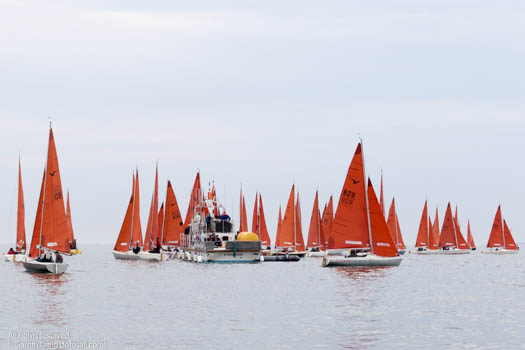
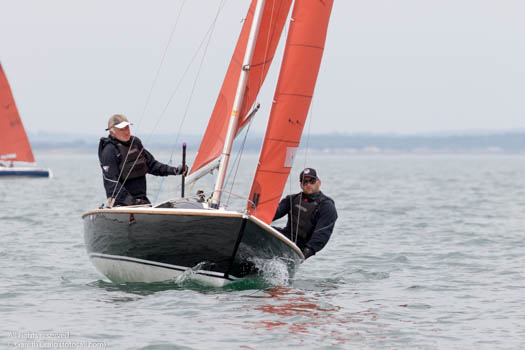


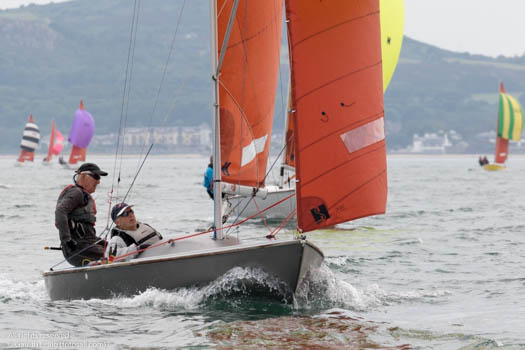

#squib – The top Irish Squib at the National Squib Championship is sixth place Aficionado, sailed by John Driscoll and David Cagney. A further two great races were sailed off Howth today. In race one, sailed in tee-shirt conditions the wind was about 9 knots and the ebb tide had just started- and was pushing the fleet over the start line. After one general recall the race was up and running. Much of the fleet opted for the pin end of the line where the tide was slightly stronger. However, the waves were choppier, which slowed the progress of the Squibs. However the boats with the skill in negotiating waves reached the windward mark first. Nigel Harris and John Stephenson in Banshee from South Caernarvonshire Yacht Club lead around the windward mark. This race was a windward leeward race with three beats. They were able to sail a conservative race and held the fleet at bay. The crews found the running legs very long due to nosing the tide. Some boats opted to sail the angles while others sailed the rhumb line which put them at a small advantage. Over the race the wind strength was increasing progressively. At the finish the placings were:
1st. Banshee, 65, Nigel Harris and John Stephenson. SCYC
2nd. Ric-O-Shea, 136, David Jones and Mark Hogan.SCYC
3rd. Lady Penelope, 819, Malcolm Hutchings and Andy Ramsay. RCYC
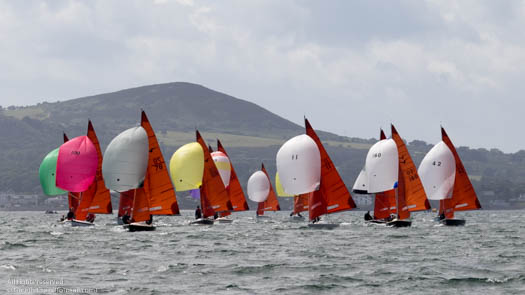
By race two the wind had increased to about 14 knots which was a challenge to those crews who needed to adjust their rig settings for the stronger wind. Again after one recall the fleet started under a 'U' flag which is like a black flag but less penalizing. Again the fleet had to decide between choppy water and a favourable tide, or calmer waters and slightly less strong tide. At the first windward mark Nigel and Jack Grogan in Helmut Shoing II had pulled out a lead of more than 10 boat-lengths. This time the race was on a triangular course. The leaders, unlike their performance yesterday, sailed a faultless race. It was a long race with four beats with a wind which increased to 25 knots at times. Unlike yesterday the wind was quite steady, and did not offer the snakes and ladders opportunities which existed yesterday. As the wind increased, the offwind legs it presented huge challenges to the crews who were not prepared for it.
Helmut Shoing won the race. At the finish the results were:
1st. Helmut Shoing II , 105, Nigel and Jack Grogan.
2nd. Ric-O-Shea, 136, David Jones and Mark Hogan.
3rd. Lady Penelope, 819, Malcolm Hutchings and Andy Ramsay.
At this stage there have been three different race winners, so what is the overall position?
1st. Ric-O-Shea, 136. 5 points.
2nd. Lady Penelope, 819, 8 points.
3rd. Helmut Shoing II , 105, 14 points.
4th. Banshee, 65, 14 points.
Top Irish boat is 6th place Aficionado, sailed by John Driscoll and David Cagney.
Top lady, in race 2 and 3 was Pamela Phelan in Squib.
Special mentions goes to Megan Pascoe and Hannah Stodel from Weymouth Sailing Club in Squibble who now lie in 24th place in the series. Megan and Hannah are 'Special Athletes' who have overcome their severe handicaps to compete on an equal footing with able bodied male athletes in this elite fleet.
Racing continues tomorrow.
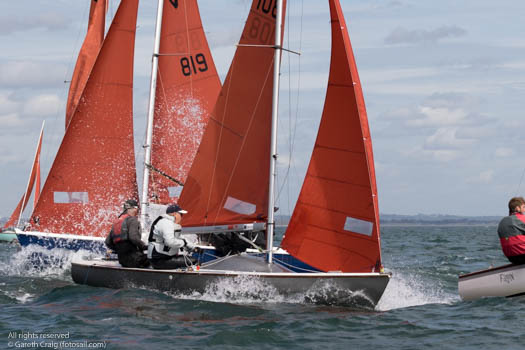
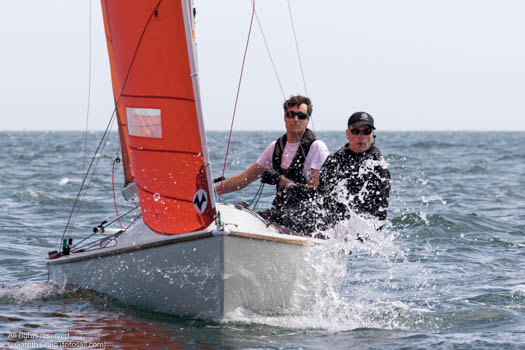
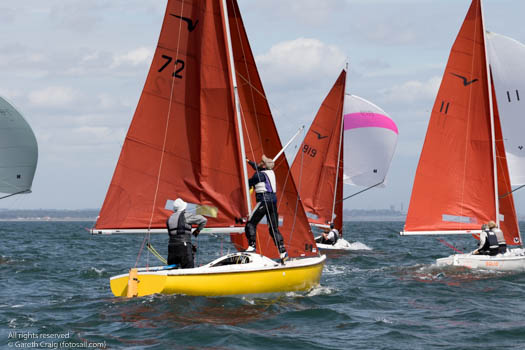
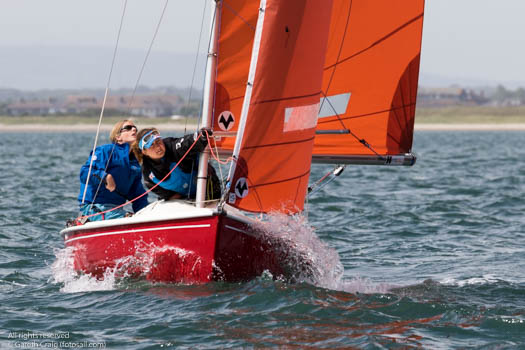
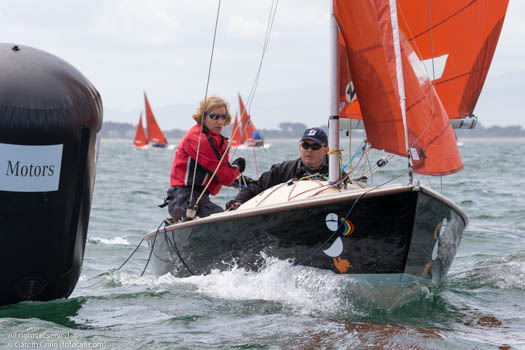
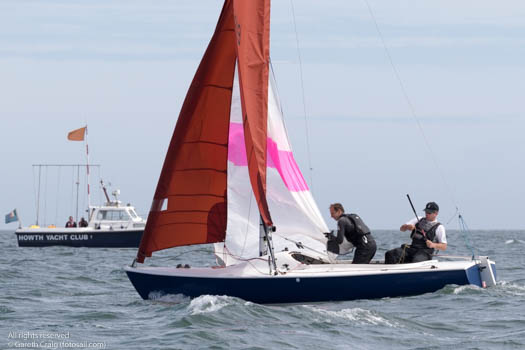
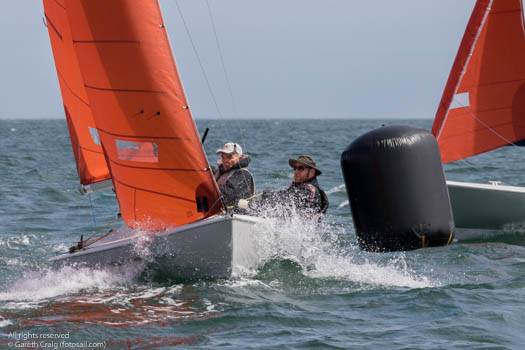
49 Squibs Start Nationals At Howth In Shifty Breeze
#squib – Despite a weather forecast of 30 km/hr winds, the National Squib Championship started today in Howth, County Dublin, Ireland, in ideal sailing conditions with sunshine and 10-16 knots of offshore wind blowing off Portmarnock beach. Having enjoyed several practice starts with a favourable flood tide, the fleet of 49 Squibs got away cleanly without any OCS victims.
The wind held plenty of surprises for the competitors. On the first beat which was more than a mile long, and the wind at the stronger end of the cycle, the wind flicked left which provided a 'get out of jail free' card to the competitors who headed to the port side of the windward leeward course. Some competitors took on board the information 'left is good'. This turned out to be a flawed piece of information. At the fist windward mark many of the top boats found themselves to be placed in the late teens or early twenties, this included David Jones and Mark Hogan from South Caernarvonshire Yacht Club in the immaculately prepared 'Ric-O-Shea', and Gerard Dyson and Tony Saltonstall from Royal Yorkshire Yacht Club in 'Alchemy'. Were they destined to remain in the mid- fleet? The answer was no.
On the first run there were very few place changes, behind Nigel and Jack Grogan from Royal Corinthian Yacht Club in 'Helmut Shoing II' who held a short lead from a tightly bunched group of Squibs behind. On the second beat the 'left option' was again good, and resulted in a shake up of the mid-placings. Again the offwind leg produced few changes.
By the third beat David Lovegrove the experienced Howth based O.O.D. had moved the windward mark to towards south. The wind continued to flick back and forth and to produce changes in strength. This time the wind favoured the boats which went right on the beat. Was it a tide issue or a wind issue. Popular opinion says that everything hinged on the changes in the wind direction. At this stage the competitors knew which way to go! Or did they?
On the final beat with the ebb tide decreasing in strength it paid to go hard right.
This left the Squibs only a run back to the leeward gate and a sharp turn to the finish line. 'Helmut Shoing II' had built up a 5 boat-length lead. All they had to do was sail the course and finish. Unfortunately, in the belief that they had another lap to complete, they gybed towards the right hand leeward mark, only to find that the other competitors had taken the left hand mark and crossed the finish line ahead of them.
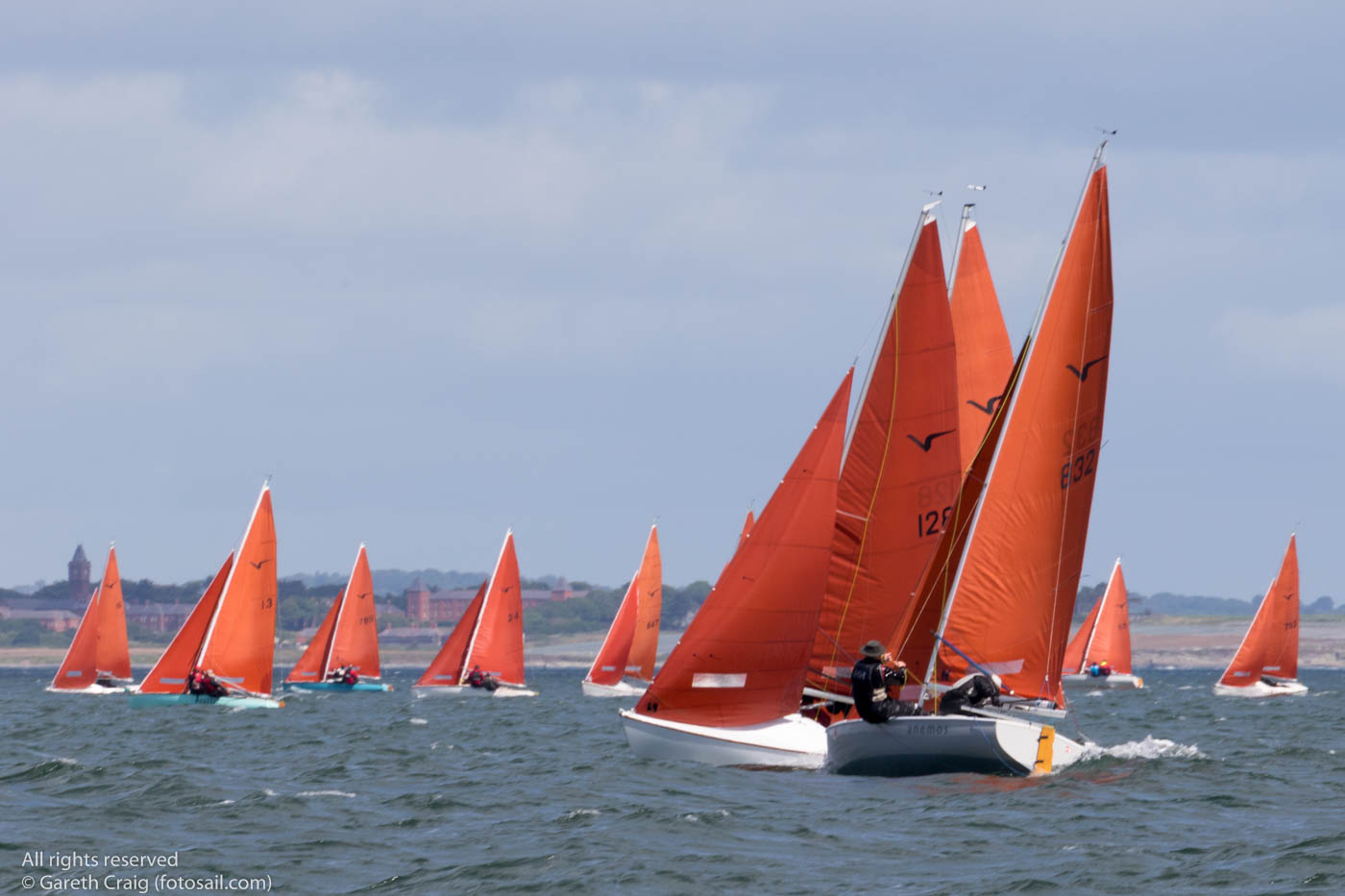
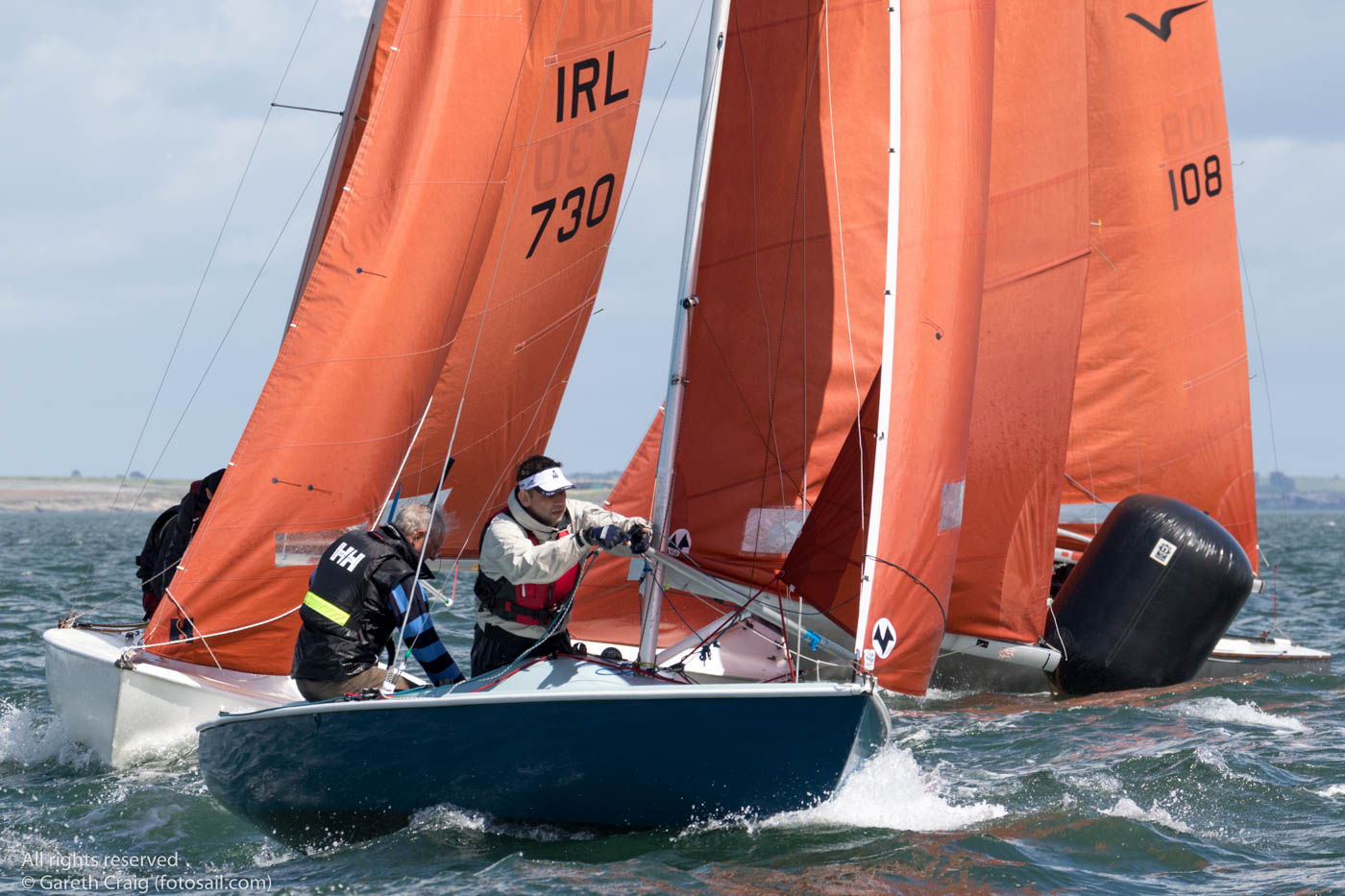

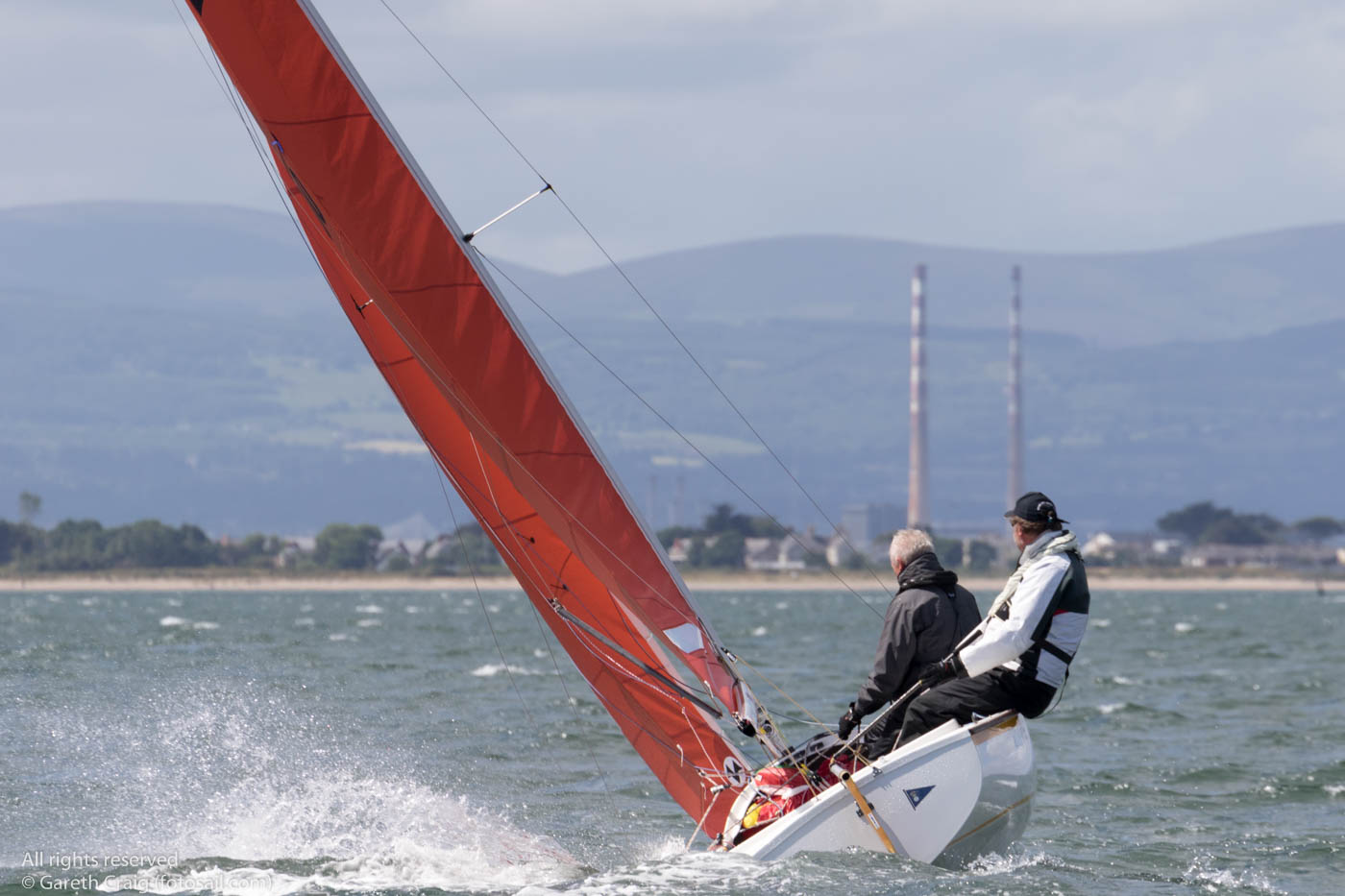
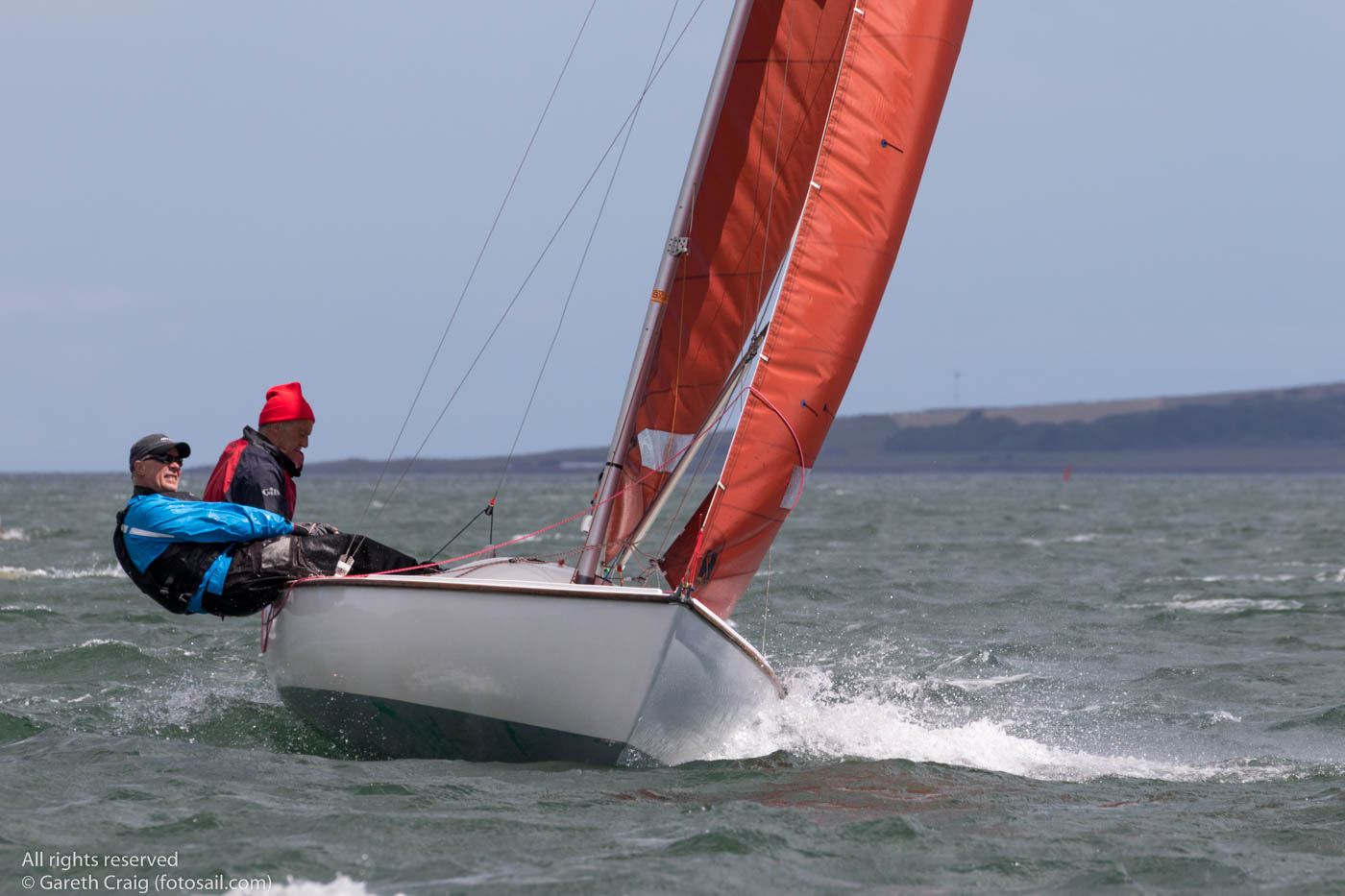


The results were:
1st. 'Ric O Shea', 136, Davy Jones and Mark Hogan.
2nd. 'Lady Penelope', 819, Malcolm Hutchings and Andy Ramsay.
3rd. 'Pani Munta' 128, Mike Probert and Richard Delves.
First Irish boat: 8th. 'Afficianado', 78, John Driscoll and David Cagney, Royal North of Ireland YC.
11th. 'Anemos', 832, Pete Evans and Conor O'Leary, Royal St. George Y.C.
First lady: 23rd. Sarah Holdstock crewing in 'Aquabats'
Squib Irish Title Goes to UK Visitors at Howth Yacht Club
#squib – Visiting UK father and son crew Nigel and Jack Grogan of the Royal Corinthian Yacht Club at Burnham–on–Crouch in Essex made a clean sweep of the Irish National Squib Championships at Howth Yacht Club today. The pair took three race wins with a final score of eight nett points and did not have to sail the last race of the series.
Local crew Fergus O'Kelly and Jonathan Wormald were second on 22 points in the 26-boat fleet.
Recent Northern Ireland Champions John Driscoll and David Cagney got off to a poor start counting two disqualifications in the six race, one discard series but reocovered well – to also count three race wins – to finish sixth overall.
Third was 2012 Irish champion Aidan O'Conell and Ross Nolan.
Was the three day Squib Championships held in Howth Yacht Club on 19-21 June just like any other regional championships with the usual suspects at the top? The answer is no. Unlike other Irish events, we had two very welcome visitors from the UK.
They were the two class sailmakers, Dick Batt and Pamela Phelan in Squib, and Nigel and Jack Grogan in Helmut Shoing II. Did they take first and second places? No they didn't.
Race one was held on Friday evening on the course north of Howth harbour where the Nationals are due to be sailed in a weeks time. Helmut Shoing showed great speed in a 10 knot breeze and ran away with the race, winning by a few minutes. Second place went to David Eccles and Phil Hutchinson in Innisallagh from the Royal North of Ireland Yacht Club, with third place going to Sam Lyness and John Reynolds in The Worm from the same club. The pattern appeared to be set. The UK teams to take the lead followed by the Northern teams. In this windward-leeward race there was a strong ebb tide and important tactical decisions to be taken on which leeward mark to round. In fact it paid to ignore the tide and to head left on the beat, where the wind pressure was greater. Three of the fastest boats in the fleet, Fagin, Aficianado and Arctic Fox which were all previous championship winners, were premature starters. This was to be significant in the overall championship results.
On Sunday there were three races, in the same westerly wind conditions. Race two was on the windward leeward course with Helmut ShoingII taking the gun from SB20 sailor Aidan O'Connell standing in for the injured Gordon Patterson with Ross Nolan in Quickstep III from R.N.I.Y.C. taking second place, and Fergus O'Kelly and Jonathan Wormaid in the mid-numbered boat Selik from the host club. Would it be possible for a mid-numbered Squib to produce consistent championship winning results?
Race three was also held in a shifty wind which flicked back and forth by up to 20 degrees. The early leaders Vincent Delany and Joe O'Byrne in Femme Fatale from the Dun Laoghaire Motor Yacht Club and Royal St. George Yacht Club were unable to resist the pressure from astern and particularly from John Driscoll and David Cagney in Afficianado on the triangular course, so at the finish it was Afficianado, Femme Fatale and Helmut ShoingII.
Race four was a windward leeward race in the shifty wind, and again saw the cool crew in Afficianado, taking the gun from Helmut Schoing and Inishallah.
Overnight it was clear that it was going to be a high scoring championship with Helmut ShoingII holding a good lead from Femme Fatale and Selik. Every competitors required to improve his consistency. Who could achieve it?
On Sunday the forecast was for eighteen knots of wind from the same direction as the previous day which would certainly present a challenge to all the crews. The shorter windward leeward race was selected by OOD Harry Gallagher and his team in their new flagship Starship Wonderprise.
Helmut Schoing showed great boat handling skill by working through the fleet from behind to take a win from Selik and Quickstep III. The eighteen knot wind never arrived, but there were heavy gusts and also some confusing light patches in the shifty offshore wind blowing from Portmarnock which demanded quick gear changing from the crews. The flood tide remained strong.
By the last race it was clear that Helmut Shoing II with three wins, a second and a third place had won the championship. They headed ashore leaving the last race to the Irish to fight out the final race between themselves. It was a longer windward-leeward race in which the wind had shifted about fifteen degrees to the north. In the early stages Afficianado and Fagin were making up for their misdeamour in the first race. They seemed to be wired together in the lead with and invisible thread. Then on the third beat Inisallagh found a windshift by heading south, and she moved to the lead. Until the finish line these three boats and QuickstepIII fought to win the race, and potentially win the championship. At the finish line after five long beats Aficianado won from Fagin and Inisallagh and QuickstepIII.
What had happened to Squib? She showed astounding speed on the first beat of almost every race, frequently rounding in first place, thereafter the problems arouse, with minor breakdowns showing that unless your boat is well prepared and tried and tested, you are putting yourself at a great disadvantage.
Are the Irish happy to have amateurs and professionals racing together on the same event? The answer is a resounding yes!
Which sailmakers products won?
Helmut Schoing II- All Hydes.
Selik- Hyde main and Batt Jib.
Quickstep III- Not Known.
Femme Fatale- Hyde jib and spinnaker and Batt mainsail.
Next big event for the Squibs is the British Isles Championships also to be sailed at Howth from the 26th June – 3rd July.
Results are downloadable below
Squib Northerns Won By Driscoll & Cagney
#squib – With weather and wind conditions that ranged from light and shifty to strong and gusty, the Rodgers & Browne Irish Squib Northerns took place last weekend (30/31st May) at the Royal North of Ireland Yacht Club. After very competitive and tight racing, John Driscoll and David Cagney on Aficionado took the title of Northern Champions.
A total of 18 boats competed with entries from the home club, Strangford Lough and all the way down to Cork. It was great to see so many squibs on the start line with a very high standard of fleet, including past Olympians, National and Northern Champions. At the end of day one the championship was very much open, leaving it all to play for on the Sunday. The conditions were tough and the race team, under the guidance of Nigel Kearney, skilfully managed to set five good races to complete the series.
On Day one, and under light conditions, race one started and with much jostling John Driscoll and David Cagney on Aficionado took first place ahead of David Eccles and Phil Hutchinson on Inshallah, Peter Kennedy and Gavin Vaughan on Joint Venture and Gordon Patterson and Ross Nolan on Quickstep III. Wyatt Wright and James Porter on Fat Boat Slim and Killyleagh boat Robert Marshall and Ryan Withers on Slipstream all putting in good performances within the top ten
Race two saw the Patterson/Nolan pairing on Quickstep III take line honours from Greg Bell and Leah McCleave on Prodigal and Des Clayton and Paul Henry on Inismara sailing a great race to take third. Johnny Miller and Sally Watson on High Flyer and Cork boat Too Dee sailed by Dave Sheehan and Carol Ann Rohan were both close to the lead at times during a race which had some massive shifts.
Race three saw a slightly stronger 10 knot breeze coming from the south, but this did nothing to remove those shifts. Eccles/Hutchinson on Inshallah were over the line early, went back, and with a nice left shift led the race on lap one from Greg Bell and John Driscoll with Gordon Patterson in fourth position. But with shifty conditions Greg bell on Prodigal got through and extended to win the race. Race three also saw Johnny Park and Bob Stinson on Gizmo climbing their way up the fleet.
Day two dawned with very different wind conditions. With dark foreboding skies, heavy rain showers and a late night the night before, a couple of competitors opted out of sailing and decided to stay on land!
Nigel Kearney got the reduced fleet racing started with a good clean start from all competitors. There was great close racing and first to round was George and Philip Cromie on Dotzboat from Killyleagh, liking the conditions. Fred Campbell was next on Halloween, Joint Venture and followed by Des Clayton on Inismara fourth. The windy condition suited new faces with new competitors appearing in the top ten. As the fleet rounded the windward mark for the second time, Joint venture led with a nice calm hoist by Andrew Vaughan, taking over from his Dad, Gavin in the crew spot. Aficionado worked up the fleet to round second following a perfect lift up to the layline, then Quickstep with a great hoist by Ross Nolan ahead of Fred Campbell on Halloween. Peter Kennedy and Andrew Vaughan on Joint Venture won, Aficionado second and Quickstep III in third position.
The fifth and final race saw Aficionado leading on the left of the beat but under pressure from Joint venture and Quickstep III, with Quickstep delaying the tack to come in late on the layline and sneak the lead from Aficionado. By the second round, Aficionado was in the lead from Joint Venture heading downwind when a big 35-knot squall covered the race course. Some boats got their kites away in time, others held on for some fun surfs, but there were a few knock downs and broaches in the fleet, with Halloween in sixth place going over and filling up with water very quickly. In the end John Driscoll and David Cagney on Aficionado won a very close final race and took championship by four points from Peter Kennedy and the Vaughans, with Gordon Patterson and Ross Nolan in third position.
Full results downloadable below :
1st Aficionado 78 RNIYC John Driscoll David Cagney
2nd Joint Venture 64 RNIYC Peter Kennedy Andrew & Gavin Vaughan
3rd Quickstep III 820 RNIYC Gordon Patterson Ross Nolan
4th Prodigal 146 RNIYC Greg Bell Leah McCleave
5th Inshallah 139 RNIYC David Eccles Phil Hutchinson
Squibs Gather at Royal North of Ireland YC
#squib – The Royal North of Ireland Yacht Club hosts the Squib Northern Irish Championship on the weekend of the 30/31 May 2015. The Championship will see entries from all the squib fleets from around Ireland with Royal North having the largest fleet of Squibs in the north. David Eccles on Inshallah will be competing to retain his title against past winners including John Driscoll on Aficionado, Gordon Patterson on Quickstep 111 and current Irish National Squib champion Ross Vaughan on Joint Venture. Commodore Thomas Anderson said " I am delighted to see the Irish Squib Class are coming back to RNIYC for the Rodgers and Browne Northern Irish Championship and to welcoming visitors from Strangford Lough, Dublin Bay and possibly Cork"
#inss – Last week, Sailing on Saturday featured the Royal Cork Yacht Club, the oldest in the world, as it comfortably donned the mantle of the ISA/Mitsubishi Motors Sailing Club of the Year 2015. This morning, we find ourselves involved with what may well be the newest sailing club in the world, the Irish National Sailing Club. It is certainly, thanks to being inaugurated nearly three months after Youghal SC was founded on 28th October 2014, the newest in Ireland. W M Nixon tries to explain it all as he finds himself in the world of Irish sailing's most complete dynamo.
Alistair Rumball is a Life Member of the Awkward Squad. Cage-rattling and pot-stirring are second nature to him. But it's not because of experiencing an unhappy childhood. On the contrary, while growing up in Malahide, his boyhood summers were bliss. He and his brother Arthur had as much sailing as they could want, fitted in between part-time jobs raising pocket-money with a morning picking potatoes at Dermot Dickie's farm along the Broadmeadow Estuary, followed by an afternoon of sailing the sea with the sun always shining, and then maybe an evening of club racing followed by the easy camaraderie among kids who are comfortable with boats.
It was an idyllic maritime environment which, over the years, has produced some of Ireland's top racing and cruising sailors. But while the young Rumball was no slouch on the race-course, the strongest feeling he had about sailing was the sheer fun of it all, the totally absorbing wonder of being in a boat and hauling on ropes to make sails change shape and help you along your chosen course over the always interesting sea.
Although he graduated from Trinity College Dublin as an engineer, he increasingly had this almost evangelical attitude to spreading the good news about the fun of sailing. And while he has something of a reputation – to say the least - for being confrontational, it's central to his contradictory character that he's an extremely good teacher. If somebody shows the slightest genuine enthusiasm about wanting to learn to sail, Alistair Rumball has been prepared to go to endless lengths to teach him or her to do so, and to do so with enjoyment.
Underlying that, we find the first of his gripes about the modern sailing scene. He reckons that it has become far too serious. Don't think for a moment, though, that he believes in a frivolous approach to boats and sailing. He's deadly serious about having everything just right as regards safety and function.
But once that's sorted, then he firmly believes that you should go out and enjoy it. He waxes lyrical about moments of sheer sailing ecstasy he has enjoyed in a wide variety of boats in many sailing locations worldwide. And whatever he may have formally set out to be in a professional career, his working life has been spent in and around boats, getting people introduced to boats and out afloat, sometimes on an almost industrial scale.
Time was when sailing skills were something you acquired by a sort of osmosis through family tradition, club opportunities, and friendship examples. That's mostly how Rumball himself learned to handle a sailing boat. But he seems to have this almost messianic zeal to teach people to sail, and he became convinced that the future lay in more structured training with a proper syllabus.
Having taken a long hard look at the population distribution of the Greater Dublin area and where they might best get afloat in worthwhile numbers, in 1978 he acquired the assets of a moribund organisation, the Dun Laoghaire Sailing School, and soon found himself giving his first lessons to two pupils using a fibreglass-clinker Darragh 14 knockabout sailing dinghy which they'd launched from the public slipway in the Coal Harbour in Dun Laoghaire. The long journey had started towards an organisation whose activities today today include top-of-the-line race training in 1720s in winning mode:
The majestic granite harbour of Dun Laoghaire was a cold place in 1978 for any young enthusiasts trying to set up an independent sailing school on a commercial basis. For the powers that be, sailing was something to be learned through family and clubs under the Junior Training Programme of the Irish Yachting Association. If you were a young person or adult from a non-sailing background but keen to learn, unless you'd an obliging and patient friend from within the sailing establishment, the expectation was that you'd take yourself off to somewhere far away like the Glenans Ireland bases in Baltimore and Bere Island and Clew Bay, and eventually reappear after a decent interval with enough experience, newfound ability and contacts to make the grade in the Dublin Bay sailing scene, where the very thought of a raw in-harbour sailing school for outsiders seemed distasteful to the establishment.
Yet hidden away in the southwest corner of Dun Laoghaire harbour, here was this gadfly of the sailing scene, Can–do Alistair with his rough and ready sailing school enthusiastically recruiting pupils anywhere and everywhere, and taking them afloat in boats which may not have been in the most pristine condition, and certainly set sails which would not be winners on the race course, yet they were safe and able, and so were he and his instructors.
Over the years, an entire cohort of people, mainly from Dublin but also from all over Ireland with a useful smattering of pupils from abroad, came to boats and sailing thanks to this wild-haired character whose love of his demanding work shone through everything he did.
Gradually the fleet expanded, and so too did the "Rumball Group's" activities, even though the very limited availability of premises on the Dun Laoghaire waterfront meant that every little square foot they had always seemed to serve at least three different purposes. But they were getting there, they opened a retail outlet in the town to sell boat gear and equipment which became Viking Marine, the school promoted itself to being the Irish National Sailing School, and they were well settled in place, using every inch of space on the ground floor of the interesting little building on the southwest corner of the harbour which used to be the Nautical College.

The man and his machines – Alistair Rumball and his chariot outside the Irish National Sailing School's HQ in Dun Laoghaire. Photo: W M Nixon
Centuries ago, seafaring education was given a significant role in Irish life in the late 1700s, the 1800s, and the early 1900s with the old Marine School a fine building on the south quays in Dublin. But its premises were re-allocated for development purposes and the school itself had its final home in Clontarf before being absorbed only as a vague memory into what is now Mount Temple Comprehensive school.
These days, the marine education focus has moved to Cork with the fabulous new National Maritime College in Ringaskiddy, but for that low period in Irish maritime life in the mid 20th century, one of the few keepers of the flame was Captain Tom Walsh who operated the little Nautical College in this fairly inconspicuous Office of Public Works building now hidden away behind the Dun Laoghaire Motor Yacht Club.

Captain Tom Walsh in teaching mode in 1957 in the INSS building when it was the Nautical College.

The 110ft barquentine which Jack Tyrrell designed for Captain Tom Walsh's Nautical College in 1954 in the hope that it would inspire the building of an Irish Tall Ship
It was the gallant Captain Walsh who in 1954 commissioned Jack Tyrrell of Arklow to design a 110ft sailing ship – a barquentine – to be Ireland's very own tall ship, our first sailing training vessel. God bless the good captain, but he was convinced that if he could just get someone in Government to see these inspiring plans, then such a ship would be on the way.
You can imagine just how far such a visionary idea travelled in the deadly dull Ireland of the 1950s. Far from getting a proper training ship built, Captain Walsh had enough trouble keeping his college in being. Yet he was a gentleman and enthusiast to the end, and after retirement he augmented his pension by testing compasses in yachts, which I remember well as he did it for me with a little cruiser in 1981. The only mutually convenient time it could be done was on a Saturday evening, and I'd to get the boat from Howth to Dun Laoghaire to do it, but the actual swinging of the compass by Tom Walsh was such a pleasant and educational experience that any thoughts of being at some Saturday night party were entirely banished.
So when you go into the main premises of the Irish National Sailing School today, it's natural to remember Captain Tom Walsh, and I like to think that he would thoroughly approve of the old building's current usage, for Alistair Rumball and his team are mighty busy during what must sometimes be an 18-hour day, and just this week – before the sailing season is really fully under way – Monday was typical, with 185 schoolkids bussed down from Maynooth for a day's coaching afloat, followed by all sorts of gatherings including a committee meeting of the newly-formed Irish National Sailing Club.
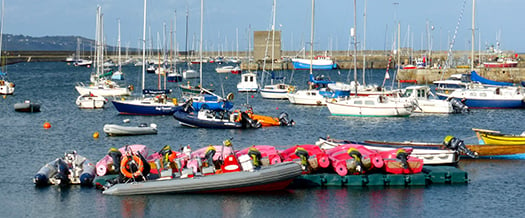
Space is so constrained that a floating dinghy park has to be used to store the smaller craft. Photo: W M Nixon
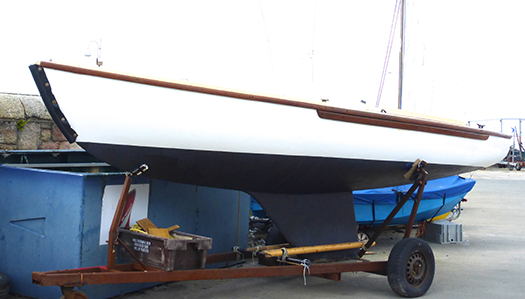
Thanks to the special INSS fendering devised by Arthur Rumball, this 35-year-old Squib has survived many seasons of tough teaching in good order. Photo: W M Nixon
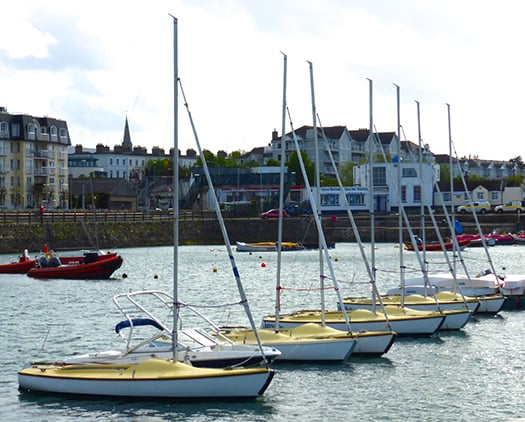
To economise on space, the Squibs berthed here, with the INSS building in the background, are double-moored. Photo: W M Nixon
Of which more anon, for this bare outline gives only a hint of the INSS's complex programme. The Rumball theme is that you have to keep operations and facilities flexible to cope with fluctuating demand, for at the height of the season the school is operating a fleet of 200 boats ranging from kayaks through sailing dinghies of increasing size, then on into keelboats of which some well-fendered Squibs are the workhorses while 1720s provide the glamour input, and finally at the top of the tree there's the Reflex 38 Lynx, bought from Galway this past winter, and becoming part of a programme headed by Alistair's son Kenneth – a Silver Youth Medallist in the 420 – who is now a fully-qualified offshore racing pro teacher, but also races the 1720s while being main operations director of a school which has five full–time employees, but in all has sixty staff at the height of the season.
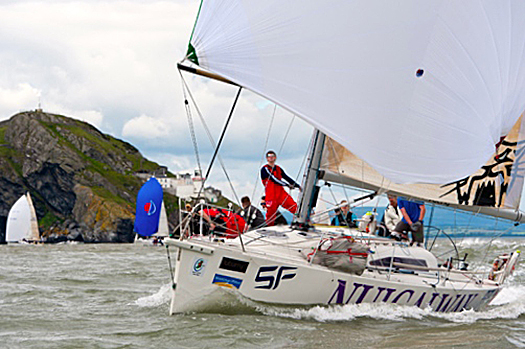
The latest addition to the INSS fleet is the Reflex 38 Lynx, seen here racing for NUI Galway during the Round Ireland. In 2015, Lynx has already scored a second overall in ISORA racing skippered by Kenneth Rumball.
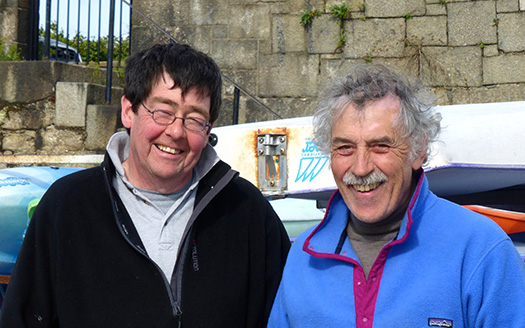
Brothers in business – seen here with his brother Alistair, Arthur Rumball (left) runs the often very busy INSS boat maintenance facility. Photo: W M Nixon
As to shoreside facilities, each summer they set up an additional seasonal summer base to the west of the West Pier with top-of the-line Portakabins at Salthill to provide facilities for those sailing dinghies and kayaks, and in addition the INSS have their own boat-maintenance unit under Arthur Rumball beside the boatyard in the Coal Harbour.
So an impressive amount of things have happened since 1978, the best of them surely being that Alistair persuaded Muriel, a country girl from one of the most beautiful parts of County Carlow, to marry him. For Muriel is a teacher by profession, and adept at being the peace-maker who smooths the waters after Alistair has been making waves, which even now still seems to be just about all the time.
That said, he gives the impression of having so many chips on his shoulder about the perceived opposition to his ventures by those in authority that you begin to think it might be just a bit of an act, for underneath it all he has a heart of gold, yet with the spirit of a lion who will fight the good fight to defend his territory and the interests of his family, friends, trainees and businesses.
The quality of the man was well revealed when the economic recession struck. At the height of the boom years, the Irish National Sailing School had a throughput of more than 2,500 people per month coming new to sailing, and it had become a vibrant and trendy part of the recreational fabric of good-time Dublin. Then around 2008, the economy went into free-fall. But the INSS survived both by making severe cutbacks in everything, and utilising another string in Alistair's bow.
Because of his ready enthusiasm to undertake just about everything and anything to do with boats, back in 1982 he'd looked after some waterborne scenes with classic small craft for the Channel 4 TV comedy-drama series The Irish RM, starring Peter Bowles and Bryan Murray, which went out between 1983 and 1985. It was grand at the time, but thirty years down the line it now seems to have a dose and more of the Paddywhackery about it. However, that was neither here nor there for Alistair Rumball in 1982, for it gave him a lucrative little sideline, and over the years since he has been the man to go to if you want to set up boats and sailing ship scenes in the Irish movie-making business.
So it's ironic, when we remember that Malahide was where the rather mouldy old Vikings of Dublin made their last base after their city had been captured by the Normans in 1171, that it should be a Malahide boy who has emerged as the behind-the-scenes captain of ships for the filming of the blockbuster series Vikings.

When you've spent most of your working life teaching people to sail, tutoring Thespian Viking crewmen on a Wicklow lake is just an ordinary part of another day at the office.
It has all been happening for some years now up in the Wicklow mountains and out on the Wicklow lakes, which have passed themselves off very well as Norwegian fjords, yet can double quite effectively as the coastal and riverside scenery of the many places where the Norwegian Vikings wreaked mayhem.
Who knows, but maybe with the passage of time the epic Vikings series will come to be seen as the epitome of Scandiwhackery, but for now, it certainly does the business . For as the Irish economy fell off a cliff, Alistair Rumball soared aloft in creating, managing, and manoeuvring a very authentic and substantial Viking longship flotilla which has provided a proper Tinseltown income to make all things possible, while helping underwrite the future of the Irish National Sailing School.
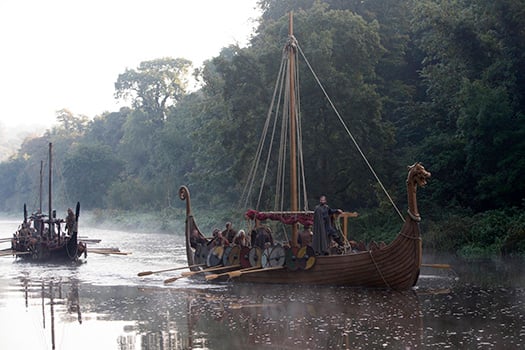
Lough Dan in County Wicklow - where Erskine Childers first sailed around 1890 – has proved remarkably versatile in providing backgrounds for the Vikings which could either be Norway itself, or else the shores of places they are raiding
But it's extraordinarily demanding and time-consuming work, even if he has a staff of 150 specialists up in the Wicklow hills, and after a year or two it became clear that he was trying to do too much. So four years ago his son Kenneth, who is now 27 and was at the time working as an accountant, moved in to take over the direction of the sailing school, and as the recession has started to recede – last year they had monthly numbers pushing back towards the 2,000 mark - Kenneth's energetic and all-encompassing input is seeing the school increasing the scale of its operations, particularly in what might be called the post-graduate side with the development of 1720s at top race level. Now the acquisition of Lynx has developed things further - she has already made what was a rather hasty debut in the first ISORA of the year, but despite being only minutes out of the box, they placed second overall, and that only by six minutes.
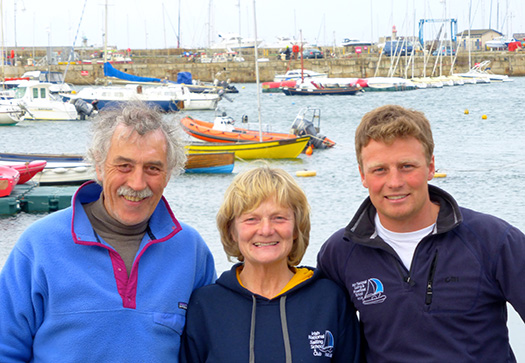
Alistair, Muriel and Kenneth Rumball. Photo: W M Nixon
This placing of racing as a natural part of the INSS syllabus has in turn led to the need for an officially-constituted club to comply with race entry requirements. But in reality the INSS has had a genuine club atmosphere for years, indeed it has more of a truly club-like atmosphere than many a historically-constituted old yacht club. So it was only a formality to bring the Irish National Sailing Club into being in January 201, but it's for real, here's a pic of the Committee of the new club meeting in the old Tom Walsh building on Monday, and if you want to join, it will cost you the outrageous sum of €10.
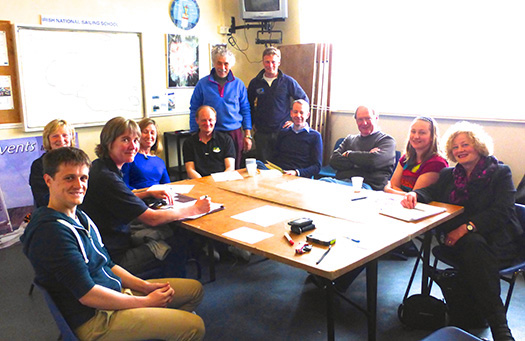
The committee and school management of the newly-formed Irish National Sailing Club are (left to right) Glyn Williams (foreground), Muriel Rumball, Joan Sheffield, Caroline Herron, Robin Jones, Alistair Rumball, Kenneth Rumball, Garrett O'Malley, Dermot Igoe, Heather Blay and Mary Beck. Photo: W M Nixon
As to how Alistair Rumball views the impending possible re-structuring of Dun Laoghaire as a cruise liner port, with inevitable limitations on the amount of sailing which can take place within the harbour, he is both an idealist and a realist.
Like many of us, he dearly wishes that this splendid granite creation could be seen as a cherished part of our heritage, not as something to be used to generate income to turn a crude profit or even just to pay its own maintenance costs. Rather, we'd ideally like to see it treated as a national asset to provide vital recreational space for everyone afloat and ashore.
But Alistair Rumball senses that the government's determination to use just about everything in public ownership to generate income will win the day, and he is already being realistic about what the regular if summer-emphasised arrival of cruise liners will mean.
In fact, he may even derive a certain sardonic satisfaction from seeing the Dun Laoghaire sailing establishment having to contemplate accepting conditions with which his school has complied ever since he began operating it.
"People should realise" he asserts, "that there are already two clearly-define shipping channels in Dun Laoghaire Harbour. One is from the harbour entrance to St Michael's Wharf, which will simply be retained if the cruise liners come. The other, much less widely known, is supposed to be from the harbour entrance to the berth at the Band Stand on the East Pier. Even at present, you are not meant to operate under sail in either of those channels, but an awful lot of boats do so."
"However, as we are a commercial operation, we have a strict policy of complying with regulations and carrying out our sail training and teaching operations in the western part of the harbour, clear of the main channel. So a cruise liner should not affect our in-harbour activities, while our larger craft going out into the bay will have to comply with shipping regulations in the entrance like everyone else".
Whatever happens, we may be sure that the Irish National Sailing School and the Irish National Sailing Club - and their splendid founder - will continue to be a thorn in the side of those who take themselves too seriously and have an inflated idea of their own importance. But if you've never been in a boat before and know nobody in sailing, yet feel a growing enthusiasm to go sailing in Dun Laoghaire, you now know where to go to experience the real thing.
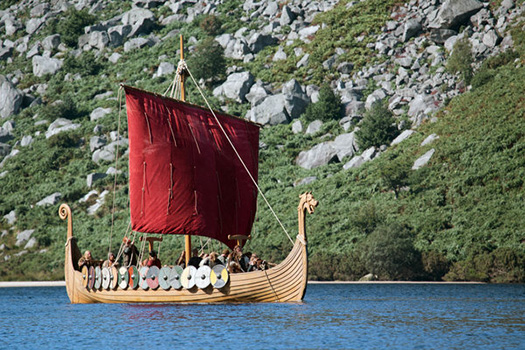
The other side of the INSS show – a Viking ship looking good on Lough Dan
#hyc – The final weekend of Howth Yacht Club's Key Capital Spring Warmer series provided another cracking days sailing yesterday writes Daragh Sheridan of HYC. There was a little less breeze than the previous weekend but there was no fall off in the excitement levels due to some great surfing conditions on the big Easterly rollers.
In the joined Class 1 and 2 Paddy Kyne's Maximus took the honours with a first and third in the final two races. He was followed in second by the star of the photos from last weekend The Big Picture (Mike and Richie Evans). Third was Dave Cullen's Checkmate being helmed by Simon Knowles as Dave Cullen was abroad.
In the largest fleet of the series Michael O'Connor on Sin Bin had a brilliantly consistent series to discard a second place to win the SB20 class for the second year running. In second was Jerry and Jimmy Dowling's Bad Kilcullen followed by Dinghy Supplies and Shane Murphy. The event provided a fantastic opportunity for the class to get in shape for their Eastern Championship to be held in Howth next weekend.
In the J24 class it was two visitors who had travelled the furthest who took the honours. First prize was Steve Atkinson from Carrickfergus followed by Martin Reilly from Sligo. In third spot was the local HYC K25 team who are preparing for a crack at the J24 Europeans later this year.
In the Squibs it was two locals to the fore with Fergus O'Kelly in first from Dave Sheahan.
The final weekend also saw the running of the Royal Alfred Niobe Trophy continuing a long standing link between the Alfred and Howth Yacht club. This saw a number of Puppeteers get their season underway with a familiar winner in the guise of Dave Clarke.
SB20s Warm-up for Howth Yacht Club Eastern Championships
#hyc – The second weekend of Howth Yacht Club's Spring Warmer series provided conditions in complete contrast to the previous week's light airs, with very strong winds testing the competitors and boats throughout the two races. Whilst it was a day to be conservative, most of the competitors in the Key Capital sponsored series could not resist the challenge of the gusty conditions and pushed their boats to the limit for the first race.
In the busy combined Class 1&2 fleet, Paddy Kyne's 'Maximus' won the first race with a minute to spare from the Kelly/Boardman half-tonner 'K1' and they then swapped positions on the finish line of their second race. In the J24 Class, Steve Atkinson's 'Bád' won the first race but Martin Reilly's 'Crazyhorse' was the only boat that managed the fierce conditions to complete race 2.
The SB20s races were unmatched for excitement and will undoubtedly provide the sailors and their boats with a great early season warm up for their Eastern Championships which are to be held in Howth directly after this series finishes. In the Squib Class, local sailor Fergus O'Kelly is declaring his intent to compete at the front end of the 2015 Squib Nationals later this year by leading the class after the first 3 races of this series.
#hyc – Competitors at the Key Capital Spring Warmer series in Howth Yacht Club were treated to glorious sunshine on the opening weekend of the season but unfortunately for all, the wind gods weren't as generous writes Daragh Sheridan.
In Race 1 in Class 2's Dave Cullen's beautifully turned out Checkmate got off to a winning start from Maximus in second and K1 in third.
The SB20 fleet was led from start to finish by Michael O'Connor in Sin Bin despite a great second beat by Ger Dempsey on Venues World. The podium was completed by Jerry Dowling's Bad Kilcullen.
The J24 fleet had shown great commitment in getting entries from as far afield as Sligo, Carrickfergus and Lough Ree. It was a dominant performance by Steve Atkinson in Bad winning both races with Martin Reilly's Crazyhorse and Finbarr Ryan taking a second a third place in each of the two races.
Local Squib guru Fergus O'Kelly heads the fleet with two first places. Second is Brian O'Hare and Alain Deladienee followed by HYC's Dave Sheahan.
Unfortunately the SB20s and Class 1 & 2 only completed one lap before the wind shut down forcing the race committee to abandon their second race.
Hopefully we will see greater number out for the second Saturday as more boats get launched and there is no Leinster match competing for competitors attention.



























